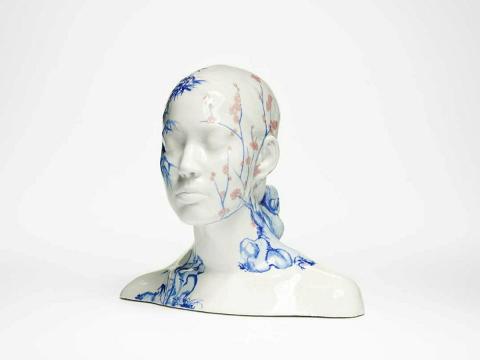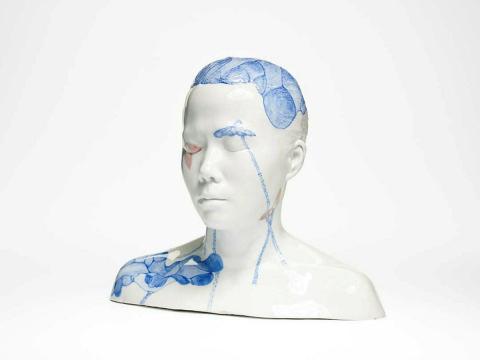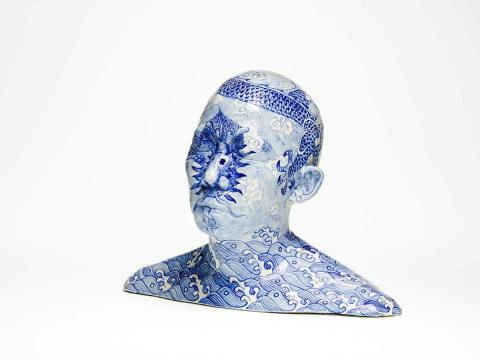AH XIAN: 'China China' series
By Claire Roberts Zoe Butt
Beyond the Future: The Third Asia-Pacific Triennial of Contemporary Art January 1999
Ah Xian was born in Beijing in 1960 and came to Australia in early 1989 as a visiting scholar at the University of Tasmania's School of Art, returning to China just weeks before the student demonstrations that led to violent confrontations at Tiananmen Square in June 1989. Deeply affected by these events, Ah Xian sought political asylum in Australia in 1990 with his brother, Liu Xiao Xian, also an artist. Beginning as a self-taught painter, Ah Xian has worked as a professional artist since the early 1980s, with his work included in group exhibitions at a number of venues, mostly in Beijing prior to his immigration to Australia. For the past few years, in a conscious attempt to investigate his heritage, Ah Xian has chosen to work with traditional Chinese crafts. Working between porcelain, jade, lacquer and cloisonné, Ah Xian's contemporary innovations renew the meanings in Chinese cultural motifs and materials. He was included in 'Face up: Contemporary Art from Australia' at the Hamburger Bahnhof, Museum of the Present, Berlin in early 2004 and in late 2003, the QAG hosted 'Ah Xian' which was same year Ah Xian had a solo exhibition at the Asia Society and Museum, New York, called 'China Refigured: The Art of Ah Xian, with selections from the Rockefeller Collection'. In 2001, Ah Xian won the 'National Sculpture Prize and Exhibition' at the National Gallery of Australia, for his Human human – lotus cloisonné figure 1 2000–01, which was subsequently acquired by the QAG. His work has been included in numerous exhibitions in Australia and overseas.
This group of four porcelain busts (2000.019–22) are among the first in a series of ongoing work by Ah Xian, called the 'China China' series. The 'China China' works are porcelain 'body copies' that have been cast from life models — men and women — and painted by the artist with traditional Chinese porcelain designs in underglaze blue ('Qing Hua'), underglaze red and some in overglaze enamels ('Dou Cai'). The brilliant white bodies, mostly heads and torsos, sometimes consciously distorted, display intimate individual details. Being porcelain, the once-precious material for which China is justly famous, they are at once permanent and fragile. China China – Bust no.1 uses a traditional Chinese scroll landscape. The sitter is Liu XiaoXian.
Before his move to Australia, Ah Xian was actively involved in avant-garde artistic activities in China. He was closely associated with the 'Stars' artists, who rose to prominence during the 1979 Democracy Wall movement. Since the early 1980s Ah Xian has consciously used the nude in his artworks. During the 1980s, the Communist Party of China sought to wipe out what was perceived as 'bourgeois liberalism', which included aspects of modern art and pornography, through successive 'anti-spiritual pollution' campaigns. These campaigns also targeted soft pornography, the category under which the nude fell. Thus Ah Xian's use of the female nude was also a form of protest.
During 1989, Ah Xian made a return visit to China where he witnessed the 4 June massacre in Tiananmen Square, Beijing. He was deeply affected by this tragedy and his responses are reflected in the work he did in the early 1990s. In these works, Ah Xian uses the language of association and allusion to refer to events of a political and social nature. The works contain motifs and ideas that are important within his oeuvre such as the nude, the wall or Great Wall — a symbol of containment and control, ID numbers, picture 'frames', the colour red — representing both communist glory and human tragedy, and 'frames' of film which may be used as 'evidence'.
In 1992 Ah Xian created a series of works made from plaster and gauze hospital bandages and included cast body parts, which was exhibited at the University of Western Sydney and the Museum of Contemporary Art. Ah Xian said that he wanted to reproduce 'something terrible, to create something like a real sight, like what happened in China'.1 The move from painting, photography and print-making to three-dimensional work may be contrasted with the ephemeral fax works of the mid- to late 1990s which depicted the dissolution or disappearance of the image, invariably a figure.
As a material, plaster created the effect that Ah Xian desired. It could easily be cast, it was white and clinical, but ultimately it was disappointing from an aesthetic point of view. The decision to work in porcelain, he said, was due to thinking about the difference in cultural things, here between the East and West:
I believe that among the disadvantages in contemporary art is the sometimes violent and vulgar and temporary nature of the art produced so I try to minimise those things in my work and people recognise porcelain as being beautiful and perfect. I originally made similar forms using plastic which was also casual, although it is fragile like porcelain and looks like porcelain, the texture is not the same.2
Ah Xian wanted to combine these ancient materials and techniques in a contemporary body of work, so he studied the basic skills of porcelain casting at the Sydney College of the Arts. In 1997, Ah Xian travelled to Jingdezhen, famous for its kilns that for centuries have produced fine porcelain objects and vessels for the Chinese court, to learn the history and traditional way of making porcelain. His aim was to establish contacts and look into the possibility of spending a longer period of time there to develop his technical knowledge of working in porcelain. In 1998 he was successful in obtaining an Australia Council grant which allowed him to spend nine months at the Jingdezhen kilns in 1999 to work with master potters and painters. While there Ah Xian learnt the processes of making the porcelain busts, which included moulding from life, forming (mould pressing), drying, glazing, decorating and firing. He went through all the procedures patiently, step by step, and solved every problem he met, so that things gradually became smooth. During the process Ah Xian was mainly in charge of moulding, forming (collaborating with the forming master) and neatening to get a green piece done. He also learned to glaze by using a spray can and how to blow the glaze by mouth.3
In creating the 'China China' series of porcelain figures, Ah Xian continued his long philosophical journey. Living in Australia has released him from the immediate pressures of Chinese politics. His distance from Chinese (physical) and Australian (cultural) society has created a space, which has allowed these works to develop. He argues that he could not have produced such work in China. The 'China China' series is the considered result of a period of deeply-felt life experience in which he and his family have straddled two cultures — Chinese and Australian, eastern and western, 'old' and 'new'.
Adapted from text by Claire Roberts in 'Ah Xian: "China, China": Recent works in porcelain' in Beyond the Future: The Third Asia-Pacific Triennial of Contemporary Art [exhibition catalogue], Queensland Art Gallery, Brisbane, 1999, p.228 and updated by Zoe Butt, Curatorial Assistant, Contemporary Asian Art, August 2004.
Endnotes
- Ah Xian. 'Self-exile of the soul', paper delivered at a seminar on contemporary Asian art organised by the Asian Arts Society of Australia and held at the AGNSW; see TAASA Review, vol. 8, no. 1, 1999, pp.8–9.
- Claire Roberts in conversation with the artist, January 1999.
- Interview with Ah Xian by Louise Bender, April 2000.
Connected objects

China China - Bust no.1 1998
- AH XIAN - Creator

China China - Bust no.3 1998
- AH XIAN - Creator

China China - Bust no.4 1998
- AH XIAN - Creator

China China - Bust no.10 1998
- AH XIAN - Creator
Metadata, copyright and sharing information
About this story
- Subject